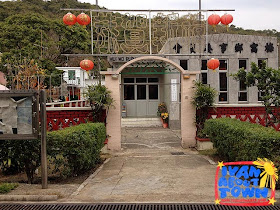Hong Kong is a modern city. But many of its rural towns and villages continue to maintain their character. If you want a different view of Hong Kong, I suggest you visit the islands. Among those I've visited are Cheung Chau during the Cheung Chau Bun Festival and Tai O Fishing Village.
Mui Wo 梅窩 on Lantau Island is just thirty minutes by ferry from Hong Kong Island (Central Pier 6). But the town retains its old charm. Its relaxed atmosphere is why many expats working in Hong Kong's financial district choose to live here with their families. Building and height restrictions ensure that development is controlled. If you visit on a weekday, it feels like you are not in Hong Kong since the sleepy town is unusually quiet.
Around the Mui Wo Ferry Pier is the commercial area of the town, with supermarkets, stores, banks, restaurants, and other establishments. That's where residents with cars also park since motorized vehicles are not allowed in the villages. A bus terminus beside the pier conveniently connects Mui Wo with the rest of Lantau, including Tung Chung (and the MTR) and Tai O Fishing Village. So if you don't want to take a ferry, a longer land trip via Tung Chung is possible. Also in the area is the Mui Wo Cooked Food Market (open from 6 a.m. to midnight) where seafood is a specialty.
For an introduction to Mui Wo, visit the Mui Wo Culture and Heritage Exhibition Center at the east end of Mui Wo Central Community Road, a few meters behind Silvermine Bay Beach. The center has available maps to guide you as you trek around the town. Chung Hau Village is what one could consider the main village of Mui Wo.
In the morning, we walked around Chung Hau and further north to Wang Tong Village. As we left the center of Chung Hau, the houses got smaller and shorter. In fact, none of them go beyond two floors. Unlike urban Hong Kong, people here enjoy their own gardens and private spaces.
Further down the road is Wang Tong, a newer community. Many of the structures here are three-floor buildings which often house apartments for rent.
As the path moves towards Butterfly Hill, the houses get sparser. Many of the houses you will see are much older ones, quite a number of them abandoned. But I learned the owners refuse to sell the properties especially because Mui Wo has become a viable option for simple living in Hong Kong.
You could actually make a loop to the rest of the villages from here. Or even walk all the way to Tung Chung which is about ten kilometers away. Another option is to walk east from Chung Hau to the Trappist Have Monastery up the hills of Mui Wo. But I was not prepared to climb.
Since it was nearing lunch, we decided to walk back to the Mui Wo Ferry Pier for lunch, passing through the rest of Chung Hau. We walked the length of Mui Wo Rural Community Road where you could find small restaurants and stores, a community center, recreational facilities, and a place where many locals play mah jong.
You definitely get to see a facet of Hong Kong that you will not find in the more popular tourist attractions. And this was just one of several villages in Mui Wo.
Before crossing the river, you will pass by the Hung Shing Temple, previously located near the beach (it collapsed due to poor maintenance) and reconstructed in Chung Hau. In front of the temple is a pair of stone lions, a female lion playing with a cub, and a male lion stepping on a gold ball. If you look closely at the male lion, you'll find that its genitals are exposed!
You will see a good number of fishing boats docked at River Silver as you cross the bridge connecting Chung Hau and Ngan Wan Estate. Mui Wo remains a fishing community.
We had lunch at a Turkish restaurant which my hosts wanted to try. You'd wonder why there are so many food options in Mui Wo despite its small population. That's because it's a popular weekend destination and these restaurants cater to those visitors. We were planning to visit Tai O that afternoon. But since it was a bit late for Tai O, we decided to explore the rest of Mui Wo. That's my next post. Read Hiking around Mui Wo 梅窩 on Lantau Island, Hong Kong [Part 2].
Thank you to Sonia Zerrudo, Toto de Ramos, and Irene Haagen, active members of the Filipino community in Hong Kong, for taking me around Mui Wo!
We had lunch at a Turkish restaurant which my hosts wanted to try. You'd wonder why there are so many food options in Mui Wo despite its small population. That's because it's a popular weekend destination and these restaurants cater to those visitors. We were planning to visit Tai O that afternoon. But since it was a bit late for Tai O, we decided to explore the rest of Mui Wo. That's my next post. Read Hiking around Mui Wo 梅窩 on Lantau Island, Hong Kong [Part 2].
Thank you to Sonia Zerrudo, Toto de Ramos, and Irene Haagen, active members of the Filipino community in Hong Kong, for taking me around Mui Wo!















No comments:
Post a Comment